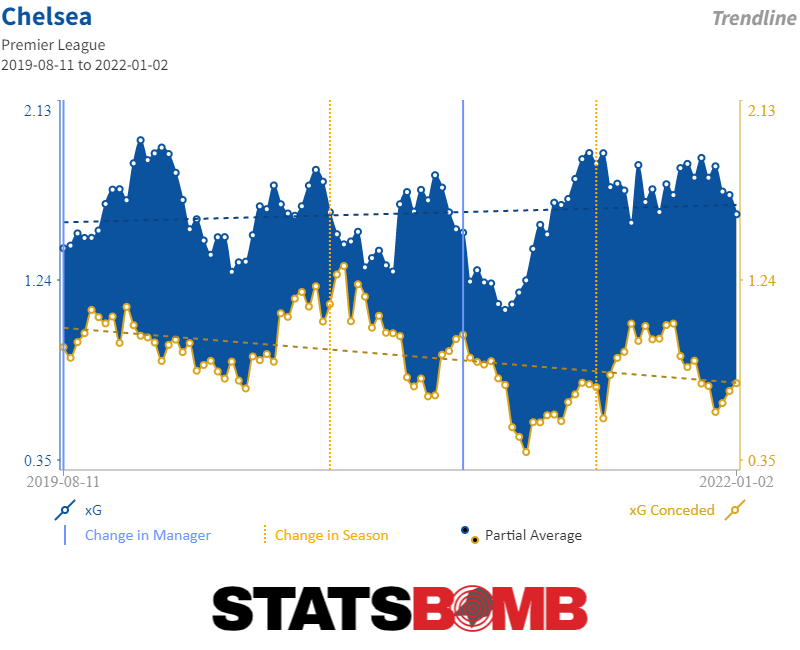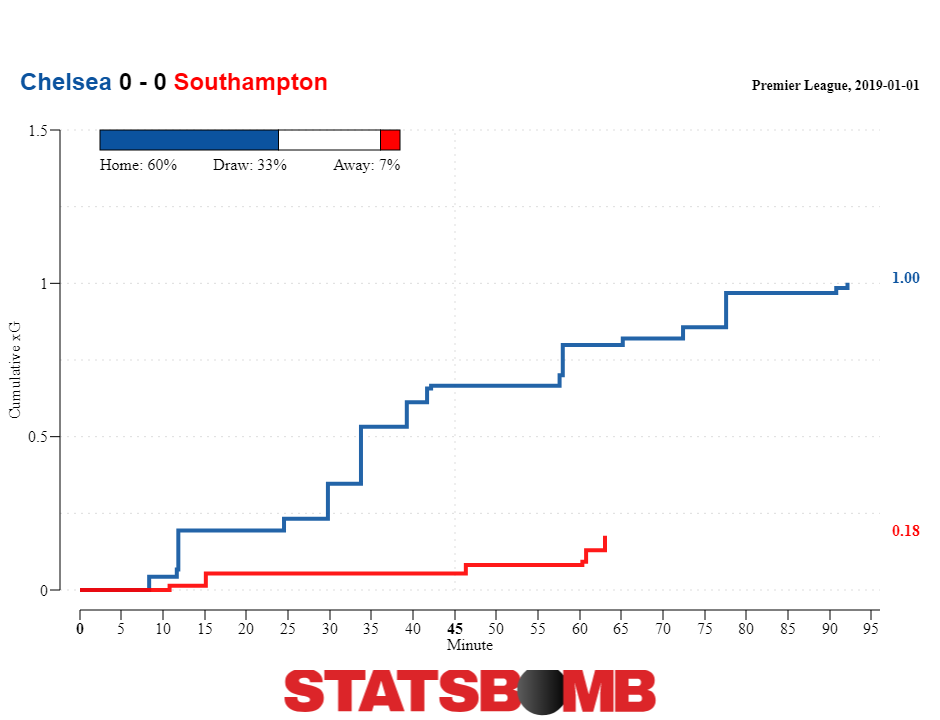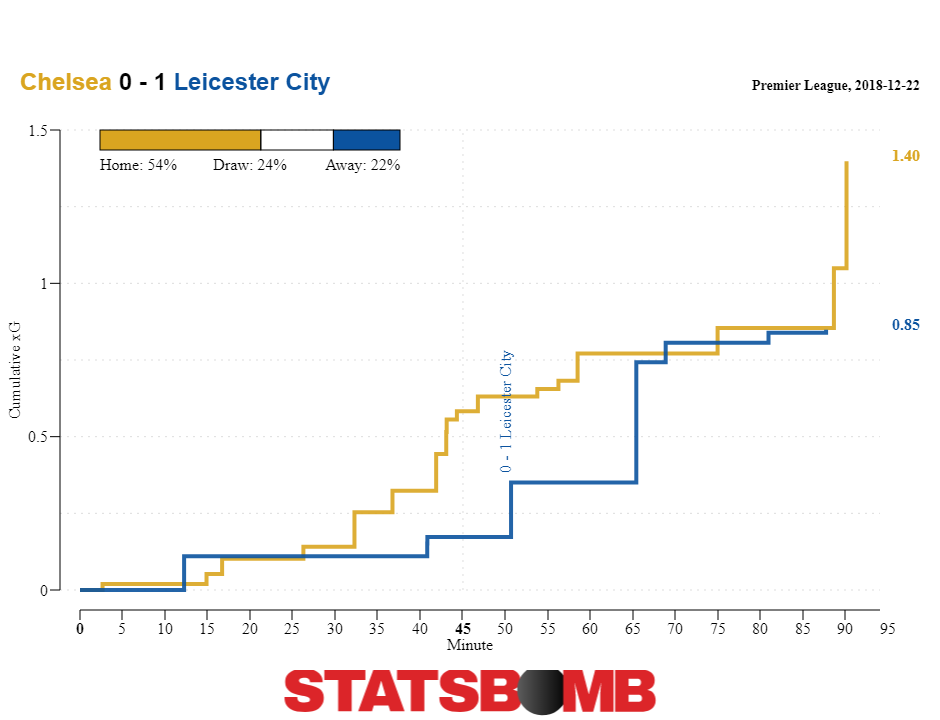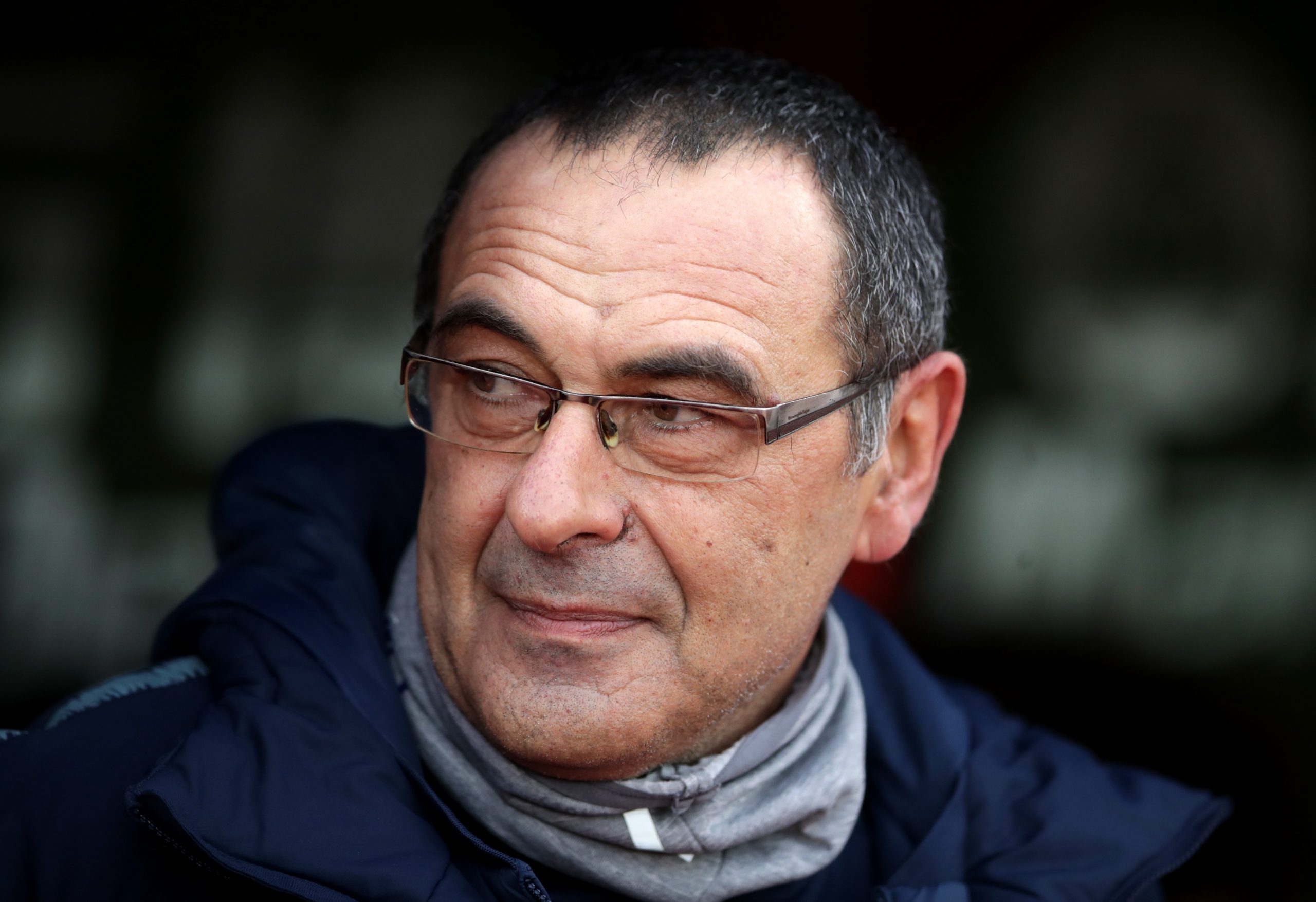Have Chelsea gotten better? Changing managers can frequently cause some degree of upheaval. Old systems are discarded and new ones are implemented. Squads which had been constructed to play in one manner must be repurposed for another. There’s friction. The hope is that as a new manager settles in, friction eases the squad learns what it’s doing, and away we go. That idea is what made the start to Chelsea’s season so enticing. Despite the friction, the team started with five straight victories. They didn’t lose their first match until November 24. If they were getting great results before the manager settled in, imagine what would happen as the season progressed. The problem is, here’s what’s happened as the season has progressed.  That’s a ten-game rolling average of Chelsea’s expected goals, and expected goals conceded, starting from the beginning of last season. Thanks to Chelsea’s very poor attacking start to the 2017-18 campaign one which ultimately doomed their season, their attacking trendline seems to be improving. But, at the same time recent attacking results have been absolutely terrible. The team is mired in the midst of a four-match slump with narrow wins against Watford and Crystal Palace sandwiched between a loss to Leicester and a 0-0 draw against Southampton, both at home. The problem isn’t that Chelsea don’t create scoring opportunities. In both the loss and the draw, they more than their season average of 15.81 shots, an average which is itself the second highest in the league. The problem is that so few of those shots are good. Their xG per shot of 0.10 is exceedingly average. Only nine teams take worse quality shots on average than Chelsea do. The combination of high volume attack and average quality makes for the third best attack in the league by expected goals, clocking in at 1.51 per game. Pounding away until something unlikely goes in the net is certainly a strategy that can work, but when it goes wrong it goes particularly ugly. Against Southampton the team’s ability to create shots dropped even further. Of their 16 shots against Southampton only five were 0.10 xG or above, and that’s how you end up with 16 shots totaling a grand total of one expected goal.
That’s a ten-game rolling average of Chelsea’s expected goals, and expected goals conceded, starting from the beginning of last season. Thanks to Chelsea’s very poor attacking start to the 2017-18 campaign one which ultimately doomed their season, their attacking trendline seems to be improving. But, at the same time recent attacking results have been absolutely terrible. The team is mired in the midst of a four-match slump with narrow wins against Watford and Crystal Palace sandwiched between a loss to Leicester and a 0-0 draw against Southampton, both at home. The problem isn’t that Chelsea don’t create scoring opportunities. In both the loss and the draw, they more than their season average of 15.81 shots, an average which is itself the second highest in the league. The problem is that so few of those shots are good. Their xG per shot of 0.10 is exceedingly average. Only nine teams take worse quality shots on average than Chelsea do. The combination of high volume attack and average quality makes for the third best attack in the league by expected goals, clocking in at 1.51 per game. Pounding away until something unlikely goes in the net is certainly a strategy that can work, but when it goes wrong it goes particularly ugly. Against Southampton the team’s ability to create shots dropped even further. Of their 16 shots against Southampton only five were 0.10 xG or above, and that’s how you end up with 16 shots totaling a grand total of one expected goal. The ultimate numbers were somewhat better in the Leicester loss, 1.40 xG from 17 shots, but the bulk of the match wouldn’t feel that way since Chelsea’s last two shots, a header from Rudiger in the 88th minute and then Marcos Alonso through on goal in the 92nd that combined for 0.54 worth of xG. Before that point Chelsea’s 15 shots had amounted for a grand total of 0.85 xG.
The ultimate numbers were somewhat better in the Leicester loss, 1.40 xG from 17 shots, but the bulk of the match wouldn’t feel that way since Chelsea’s last two shots, a header from Rudiger in the 88th minute and then Marcos Alonso through on goal in the 92nd that combined for 0.54 worth of xG. Before that point Chelsea’s 15 shots had amounted for a grand total of 0.85 xG.  Boring old high possession, high shot volume styles can work. And broadly, it’s important to note, that it is working for Chelsea. Despite their indifferent form over the festive period the team sits in fourth place, and has the third best xG difference, 0.66, in the Premier League. Chelsea are good. They’re probably going to qualify for the Champions League. That’s not something to sneeze at. They’re just not any better than they were. This season they’re at 1.51 xG per match. Last season they were at 1.45. They’re conceding 0.85 xG per match, last season it was 0.89. They aren’t even really all that different when it comes to shot numbers. They’re taking 15.81 this season, they actually took more, 16.13, last year. The only place where the shots look different statistically is on defense where the team is conceding fewer shots, 8.86 to 10.05 but also worse ones. Chelsea average xG per shot conceded has ticked up slightly from 0.09 to 0.10. For all the talk about Sarri ball, and the new emphasis on possession and the switch from a back three to a back four. None of it has moved the needle when it comes to results, or even underlying shot numbers. Chelsea certainly play differently, but they aren’t playing any better. Under Antonio Conte the team was defensively strong and uninterested in possession. When they forced turnovers they would try to beat their opponent down the field, and when that failed they’d take a speculative shot rather than sacrifice their defensive positioning. And then they’d do it all over agan. Under Sarri, the team’s approach is entirely different. They want to use the ball and break opponents down, they want to take good shots after carving opponents apart. The problem is that they are failing to do that. So, when they prove unable to break opponents down, they take speculative shots, press to get the ball back and then do it all over again. The hope was, and remains, that Sarri could tactically elevate the squad beyond the performances that Conte got. So far Chelsea’s new style, while it certainly is different, hasn’t made them better. Sarri has faced distinct challenges in the Premier League. Most teams are simply uninterested in pressing the ball, even when Chelsea’s midfield, led by Joginho try and draw them out. The teams that do press are generally quite good at it. And so Chelsea are left smashing their head against defenses that sit deeper and are less inclined to shift to and from the ball than they were in Italy. Another major problem is that Mateo Kovacic, after a promising start, has failed to become a real attacking presence from midfield. And while Ross Barkley, as ever, has the physical tools to succeed, he has, as ever, not demonstrated the tactical awareness to be a complementary attacker in this system. Sarri’s system depends on midfielders breaking lines and then breaking into the box. Marek Hamsik went from great to superstar filling this role for Sarri at Napoli. None of this means that Chelsea can’t develop. They can. But, it also might take another round of purchases. Cristian Pulisic fills part of that need. He’ll certainly play lots of minutes on the wing, given Pedro and Willian’s age, but he could also end up slotting into that midfield role. Chelsea are also rumored to be casting around for a striker, with Alvaro Morata frequently benched, Olivier Giroud frequently old, and Eden Hazard frequently needed in his natural wing position. At some point though filling those holes changes the story. Bringing in more talented players will certainly improve the squad. And, to some degree, which players are purchased will be dictated by which holes Sarri need to fill. But, at the same time getting Sarri better players to make the team better isn’t really Sarri’s tactics improving Chelsea, it’s the fact that more and better players are being added to the team. It’s too early to write off Sarri, but the first half of his first season with Chelsea illuminates the major challenge that managers face. It’s easy to change how a team plays. It’s incredibly hard to change how good they are.
Boring old high possession, high shot volume styles can work. And broadly, it’s important to note, that it is working for Chelsea. Despite their indifferent form over the festive period the team sits in fourth place, and has the third best xG difference, 0.66, in the Premier League. Chelsea are good. They’re probably going to qualify for the Champions League. That’s not something to sneeze at. They’re just not any better than they were. This season they’re at 1.51 xG per match. Last season they were at 1.45. They’re conceding 0.85 xG per match, last season it was 0.89. They aren’t even really all that different when it comes to shot numbers. They’re taking 15.81 this season, they actually took more, 16.13, last year. The only place where the shots look different statistically is on defense where the team is conceding fewer shots, 8.86 to 10.05 but also worse ones. Chelsea average xG per shot conceded has ticked up slightly from 0.09 to 0.10. For all the talk about Sarri ball, and the new emphasis on possession and the switch from a back three to a back four. None of it has moved the needle when it comes to results, or even underlying shot numbers. Chelsea certainly play differently, but they aren’t playing any better. Under Antonio Conte the team was defensively strong and uninterested in possession. When they forced turnovers they would try to beat their opponent down the field, and when that failed they’d take a speculative shot rather than sacrifice their defensive positioning. And then they’d do it all over agan. Under Sarri, the team’s approach is entirely different. They want to use the ball and break opponents down, they want to take good shots after carving opponents apart. The problem is that they are failing to do that. So, when they prove unable to break opponents down, they take speculative shots, press to get the ball back and then do it all over again. The hope was, and remains, that Sarri could tactically elevate the squad beyond the performances that Conte got. So far Chelsea’s new style, while it certainly is different, hasn’t made them better. Sarri has faced distinct challenges in the Premier League. Most teams are simply uninterested in pressing the ball, even when Chelsea’s midfield, led by Joginho try and draw them out. The teams that do press are generally quite good at it. And so Chelsea are left smashing their head against defenses that sit deeper and are less inclined to shift to and from the ball than they were in Italy. Another major problem is that Mateo Kovacic, after a promising start, has failed to become a real attacking presence from midfield. And while Ross Barkley, as ever, has the physical tools to succeed, he has, as ever, not demonstrated the tactical awareness to be a complementary attacker in this system. Sarri’s system depends on midfielders breaking lines and then breaking into the box. Marek Hamsik went from great to superstar filling this role for Sarri at Napoli. None of this means that Chelsea can’t develop. They can. But, it also might take another round of purchases. Cristian Pulisic fills part of that need. He’ll certainly play lots of minutes on the wing, given Pedro and Willian’s age, but he could also end up slotting into that midfield role. Chelsea are also rumored to be casting around for a striker, with Alvaro Morata frequently benched, Olivier Giroud frequently old, and Eden Hazard frequently needed in his natural wing position. At some point though filling those holes changes the story. Bringing in more talented players will certainly improve the squad. And, to some degree, which players are purchased will be dictated by which holes Sarri need to fill. But, at the same time getting Sarri better players to make the team better isn’t really Sarri’s tactics improving Chelsea, it’s the fact that more and better players are being added to the team. It’s too early to write off Sarri, but the first half of his first season with Chelsea illuminates the major challenge that managers face. It’s easy to change how a team plays. It’s incredibly hard to change how good they are.
2019
Chelsea and the Challenge of Sarriball
By Kevin Lawson
|
January 4, 2019
